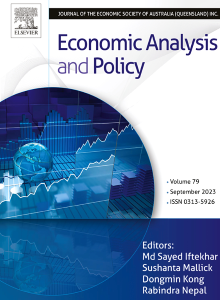Digital–real economy integration and urban low-carbon development in China
IF 7.9
2区 经济学
Q1 ECONOMICS
引用次数: 0
Abstract
Digital–real economy integration (DRI) is a fundamental prerequisite for cultivating enhanced productivity. Furthermore, it represents an efficacious strategy for expediting the attainment of China's carbon peak and neutrality objectives. This study empirically examines the impact, mechanisms, and spatial effects of DRI on urban low-carbon development (ULCD) by the two-way fixed effect model and the Spatial Durbin Model (SDM), using data from 285 Chinese cities from 2011 to 2021. The results show that: (1) DRI has a remarkable promotional effect on ULCD, and it can considerably improve low-carbon production, living, and ecology. (2) DRI primarily promotes ULCD by improving technological innovation, resource allocation, and industrial agglomeration. (3) The positive driving force of DRI on ULCD is more significant in cities that are central, coastal, nonold-industrial, nonenvironmental, and nonresource-based cities. (4) DRI and ULCD exhibit a strong spatial correlation, and DRI has a negative spatial spillover effect on neighboring regions’ ULCD. This study provides insights for a systematic understanding of DRI and ULCD, with policy implications for promoting cities’ digitalization and low-carbon development.
求助全文
约1分钟内获得全文
求助全文
来源期刊

Economic Analysis and Policy
ECONOMICS-
CiteScore
9.80
自引率
9.20%
发文量
231
审稿时长
93 days
期刊介绍:
Economic Analysis and Policy (established 1970) publishes articles from all branches of economics with a particular focus on research, theoretical and applied, which has strong policy relevance. The journal also publishes survey articles and empirical replications on key policy issues. Authors are expected to highlight the main insights in a non-technical introduction and in the conclusion.
 求助内容:
求助内容: 应助结果提醒方式:
应助结果提醒方式:


